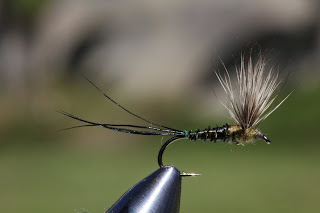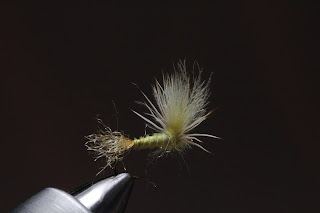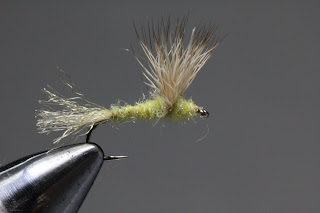This will be a good imitation of the Small Western Green Drake or even a blue-winged olive.
Sunday, January 30, 2011
Biot Body Dun with Split Tails
These photos are of another variation on the comparadun fly. In this case, I used moose body hair for the tails; goose biot for the body; and the deer hair comparadun style wing.
This will be a good imitation of the Small Western Green Drake or even a blue-winged olive.




This will be a good imitation of the Small Western Green Drake or even a blue-winged olive.
Friday, January 28, 2011
Tuesday, January 25, 2011
CDC and Deer Hair Sparkle Flav
I am playing around with variations for use this coming summer in case I encounter the Flav hatch I fished last summer on the Henry's Fork. The best dry fly pattern last summer was the standard Sparkle Dun with an olive body. I am thnking: "why not incorporate a biot body as well as CDC with the deer hair?".
The thorax is dubbed with CDC plumes.
Monday, January 24, 2011
CDC and Elk Egg-Laying Caddis
I adhere to the belief that when we see a "heavy hatch" of caddis flies, we are probably witnessing swarming males above the water and female egg-laying caddis diving to the water to release the eggs from their egg sacks - sort of a reverse hatch! Most of the females swim down to the bottom to release their eggs there. Trout key on these females and their egg sacks.
Gary LaFontaine reviewed this situation in his book: Caddisflies
Saturday, January 22, 2011
CDC and Elk Designed by Hans Weilenmann
I have never met Hans in person, but I have been in occasional internet contact with him ever since he put me in contact with Lawrence Waldron to acquire one of Lawrence's LAW vises over 15 years ago. Hans was also kind enough to put some of my flies on his famous "Flytier's Page" web page: Danica.com/FLYTIER/.
Contact with Hans usually occurs when I ask him for help in trying to improve my photography of flies. He is recognized as perhaps the best in the field.
Hans developed the CDC and Elk pattern a number of years ago and it is quite popular. It is sort of a misnomer as the wing material is actually deer hair. However, I believe it was so named as it is a variation on Al Troth's Elk Hair pattern - thus the name "Elk" remains........
Anyway, not sure if my tying does his fly justice, but here is my version of his fly. My CDC has plumes shorter than those used by Hans, I believe. The first two photos have the pronounced head - more like those tied by Hans. The bottom has a shorter head - more my style.
Sparkle Blue Winged Olive Comparadun

I believe this fly could also be used as a Small Western Green Drake emerging dun. It has the trailing shuck.
There are two versions of dubbing material shown. First, the traditional superfine dubbing; and second, an ice dubbing.
Paraloop Style Sparkle PMD
There are two views of this fly. From the side and from above. The Paraloop style fly is easy to tie - especially if you have a gallows tool. You simply tie in the tail (trailing shuck in this case); dub the abdomen; make a thread loop to the gallows tool and wrap 5-6 turns of hackle up the thread loop and the same back down; tie off the hackle, release tension on the thread loop and dub the thorax in front of it; finally tie the hackled thread loop off at the eye.
The paraloop style, I feel, floats even better than the traditional parachute fly. In addition, the sort of "mohawk" hackle down the centerline of the fly adds a bit of a wing view.
Biot Body CDC and Deer Sparkle Dun
I have been trying to improve the photo of this fly. Have gotten good advice from a number of people. It is difficult to photograph a fly - especially at other than a "straight on" side view as it is easy to then lose depth of field.
This is one of my favorite new flies. It combines a biot body; Craig Mathews' zelon trailing shuck; and CDC with the deer hair for the "wing". The light dubbing at the thorax is an Orvis Antron/Hair dubbing. This particular pattern is a PMD in coloration. I think it will work quite well.
Let me know what you think.
Thanks for looking.
Thursday, January 20, 2011
A Flav Spinner
Well, it is really tough to take a photo of a spinner. It really only makes sense from above or below. I have included a side view and then a view from above. The last photo is of a similar fly tied with a darker, ice dubbing for the thorax. So, this is to represent a Flav Spinner.



Wednesday, January 19, 2011
Can't Resist Tying These Biot Bodied Flavs
The fly floats due to the "wing" of a mixture of CDC and Deer Hair. I use the sparkle shuck in lieu of a tail as this would be a "just emerged" flav still with the shuck.
Tuesday, January 18, 2011
Back to Tying Sparkle Duns with ice dubbing
I took these photos with my new camera/lens. I believe the photo is better than preceding photos. Let me know what you think. The first four below use a biot body and antron/hair dubbing at the thorax. The others use ice dubbing
Thanks,
Byron







Thanks,
Byron
Monday, January 17, 2011
A Sparkle Dun with CDC and Partridge instead of Deer Hair

Just trying a different method of tying a Sparkle Dun. Craig Mathews and his partner are famous for the Sparkle Dun Comparadun which uses a "wing" of deer hair. In this fly, I use CDC and Partridge for the wing.
The photo did not come out too well, but I am anxious to try this fly out this summer.
Friday, January 14, 2011
Biot Body CDC and Deer Hair Comparadun
Photo not coming out the best on this one, but am trying different dubbing materials above the biot body. The top fly has normal superfine dubbing. Others have Orvis "Ice" dubbing for the thorax.
Thursday, January 13, 2011
Al Troth Elk Hair Caddis to the Winner
I attended the University of Missouri, Columbia for my undergraduate degree. I follow the Missouri Tiger Football team each year. This year, they played the University of Iowa in a bowl game. Since I spent years in Iowa, I bet my buddies back in Iowa on the game. Missouri lost and I have to tie a dozen Al Troth Elk Hairs for one of them.
Wednesday, January 12, 2011
Subscribe to:
Posts (Atom)




